ARCHIVED: Chapter 3: Young people in Canada: their health and well-being – The Home

Adolescence is a period during which connectedness, or a strong sense of closeness, to the family decreases (Resnick, 2000) and attachment to peers increases (Collins and Russel, 1991; Larson and Richards, 1991; Fulgini, Eccles, Barber, and Clements, 2001). However, support from parents remains vital to the positive development of adolescents (Nada-Raja, McGee, and Stanton, 1992) and is an essential protective factor against anti-social behaviour and delinquency (Hawkins, Catalano, and Miller, 1992; Nada-Raja et al., 1992; Dornbusch, Erickson, Laird, and Wong, 2001). Such support consists of a warm and nurturing relationship, positive bonding, and parental monitoring of adolescent activities (Dekovic, 1999).
This chapter examines the relationships of students to their parents across Grades 6 to 10. They were assessed by asking adolescents about how well they could communicate with their parents; to what extent they felt understood and trusted by their parents; as well as conflicts that came up with their parents.
Family Structure
It is important to note that with the change in the structure of Canadian families, not all respondents were referring to a single nuclear family. The HBSC survey findings indicate that 73 percent of students lived with both parents, 11 percent in blended families, 12 percent in single-mother households, and only 2 percent in single-father households. A further 2 percent reported that they had other living arrangements.
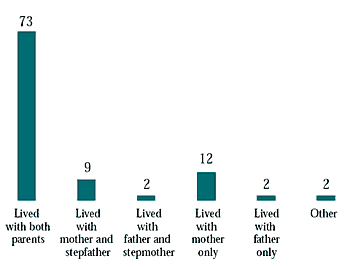
Communication With Parents
Effective communication is a primary feature of a good parent-child relationship (Jackson, Bijstra, Oostra, and Bosma, 1998). Higher proportions of both boys and girls in the HBSC sample found it easy to confide in their mothers than in their fathers (Figures 3.2 and 3.3), although there was a steady decline in the ease of talking to either parent in the older grades. Overall, girls experienced less ease of communication with their fathers throughout adolescence. By the time they were in Grade 10, only one-third of girls were comfortable talking to their fathers about things that bother them, compared with over 50 percent of boys. These findings are consistent with others in the literature that show mothers to be more comfortable conversing with their children and discussing issues of emotional relevance than are fathers (Leaper, Anderson, and Sanders, 1998; Fivush, Brotman, Buckner, and Goodman, 2000).
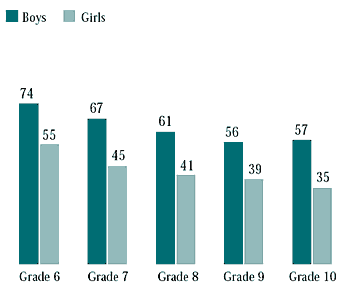
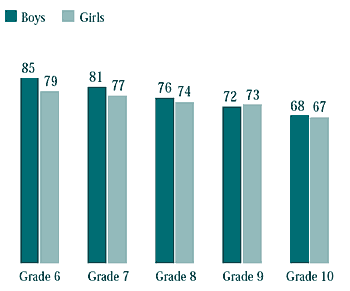
Home Life and Relationship With Parents
It was clear that most students in the HBSC sample had a happy home life (Figure 3.4). Nevertheless, reports of happiness at home decreased as students moved up through the higher grades. This decline was more pronounced for girls. In Grade 10, 15 percent fewer girls than in Grade 6 said they were happy with their lives at home, compared with only an 11 percent decline for boys. The need in older adolescence for increased autonomy and independence is likely to strain relationships with parents and may result in decreased reports of happiness at home (Bergman and Scott, 2001).
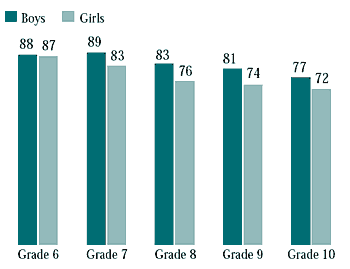
A clear gender difference existed in students' relationships with their parents. Overall, more boys reported being better understood by parents across Grades 6 to 10 (Figure 3.5). The majority of students across the five grades felt trusted by their parents (Figure 3.6), although there were gender differences at the Grade 8 level. Girls in Grades 8 to 10 tended to have more arguments with their parents (Figure 3.7) and were more likely to consider leaving home at times (Figure 3.8).
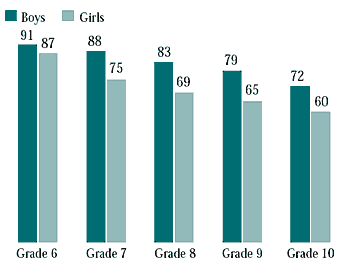
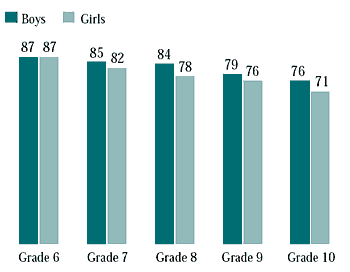
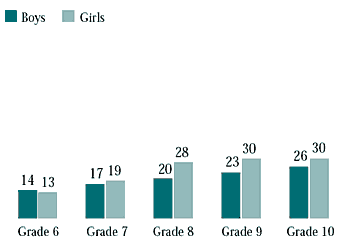
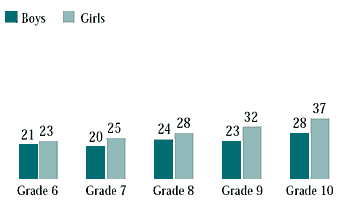

Conflict with parents appears to be a normative part of early adolescent development (Baer, 1999). Common sources of conflict between parents and adolescents are related to friends, money issues, watching television, telephone use, going out, time at homework, household chores, and fighting with siblings (Barber and Delfabbro, 2000). The gender differences in parental relationships found in the HBSC study could reflect how transitions into adolescence are handled differently for boys and girls regarding dating, curfew, and peer selection. For example, in the recent Canadian Youth Sexual Health and HIV/AIDS Study, both parents were found to be more supportive of their sons' dating relationships than those of their daughters (Boyce, Doherty, MacKinnon, and Fortin, 2003).
The majority of students valued what their parents thought of them and indicated a desire for parental approval. Students in Grade 6 were the most concerned about what their parents thought of them. By Grade 8, almost 10 percent fewer students cared about their parents' perceptions of them, with no significant change thereafter (Figure 3.9).
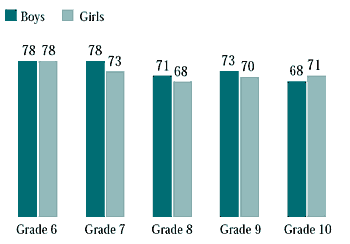
Students who fail to meet their parents' expectations may experience significant strain in their relationships with their parents (Noack and Puschner, 1999). More boys than girls felt that their parents expected too much of them in general (Figure 3.10), specifically regarding school (Figure 3.11) and especially between Grades 8 and 10. Almost one-third of all students reported that their parents' expectations regarding school were too high. Research involving Canadian adolescents indicates that because girls mature earlier than boys do, they are generally more receptive to social influence and therefore tend to be more accepting of their parents' involvement in school activities compared with boys (Deslandes and Cloutier, 2002).
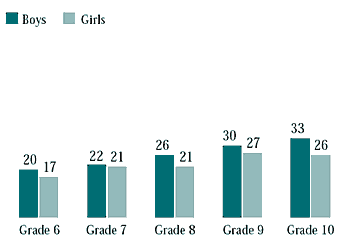
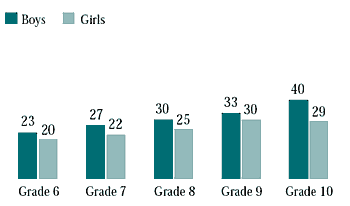
Barber (1997) suggests that there is a need to balance parenting styles that are too controlling and restrictive, allowing little room and opportunities for decision-making, with styles that are very lax, with no parental involvement. High expectations that are perceived as strict parental control enhance student motivation and achievement when balanced with emotional support and encouraging behaviours (Noack and Puschner, 1999).
Parent Relationship Scale
A parent relationship scale was created using items in this survey. Correlations between the scale and selected variables in the HBSC survey reflect how students' relationships with their parents are linked to other issues in their lives (Table 3.1). Grade 10 students who had a more positive relationship with their parents were more likely to be satisfied with their lives. On the other hand, students with a more positive relationship with their parents were less likely to smoke, drink alcohol, use marijuana, and have friends who were involved in risk behaviours. Students with a more positive relationship with their parents were somewhat less likely to engage in sexual intercourse.
Family Affluence Scale and Relationship With Parents
The association between the family affluence scale (FAS, a measure of socio-economic status discussed in Chapter 2, Socio-Economic Inequalities) and the parent relationship scale was examined (Figures 3.12 and 3.13). Half of the students, both boys and girls, at the low end of the FAS said they had poor relationships with their parents, compared with a third of students at the high end of FAS. More students at the high end of FAS reported having good relationships with their parents.
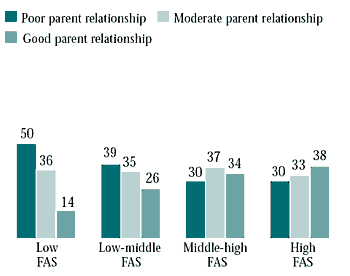
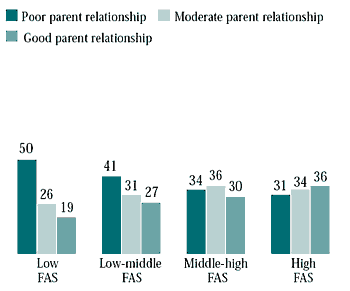
When asked about the willingness of parents to help with problems at school, students at the low end of FAS said they received less support from their parents than did students at the high end (Figure 3.14). Interestingly, 70 percent of girls at the low end of FAS reported relatively high levels of parent support with school problems, compared with only 59 percent of boys.
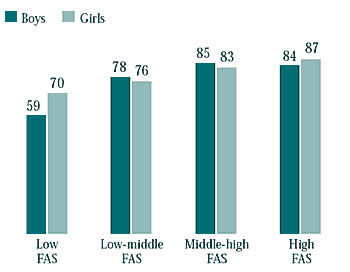
There also appears to be a relationship between family affluence and having a happy home life (Figure 3.15). A little over half of students at the low end of FAS reported being happy with their home lives, compared with over 80 percent of those at the middle-high and high ends of FAS.
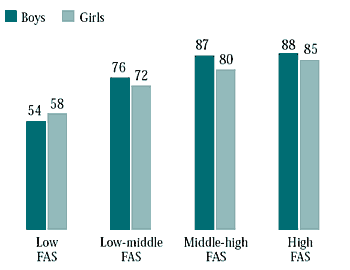
Major Findings
- Older youth, especially girls, reported having more difficulties in talking to their fathers.
- Older girls said they received less parental understanding and trust and were less satisfied with home life.
- Older girls reported more arguments with their parents and more desire to leave home.
- There was no difference in students, across age or gender, regarding the importance of parental approval.
- More boys than girls felt that their parents' expectations were too high.
- Good relationships with parents were related to higher life satisfaction.
- Poor relationships with parents were related to risk-taking behaviours in students.
- Family affluence affected student-parent relationships, parent support at school, and satisfaction with home life.